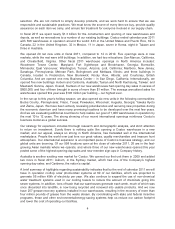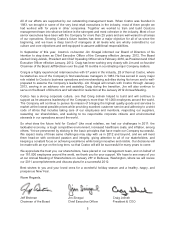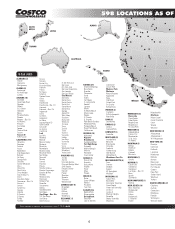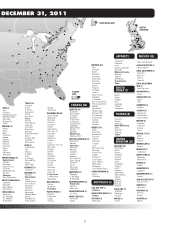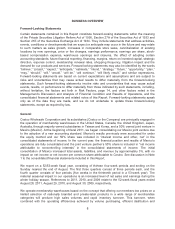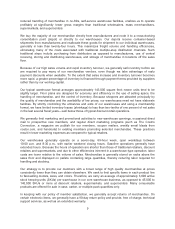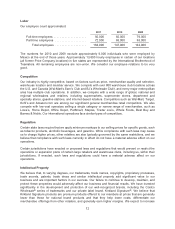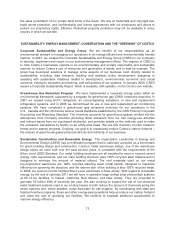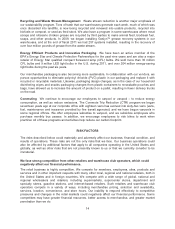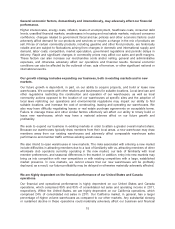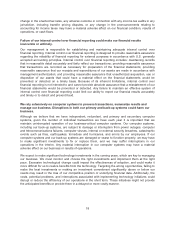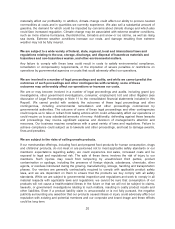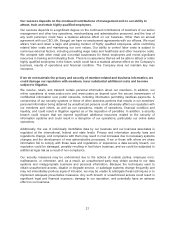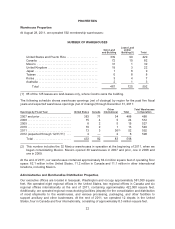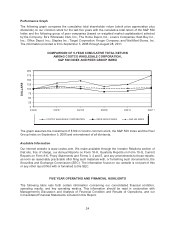Costco 2011 Annual Report Download - page 16
Download and view the complete annual report
Please find page 16 of the 2011 Costco annual report below. You can navigate through the pages in the report by either clicking on the pages listed below, or by using the keyword search tool below to find specific information within the annual report.Recycling and Waste Stream Management Waste stream reduction is another major emphasis of
our sustainability program. Tons of trash that our warehouses generate each week, much of which was
once discarded into landfills, is now being recycled and renewed into usable products, recycled into
biofuels or compost, or used as feed stock. We also have a program in some warehouses where meat
scraps and rotisserie chicken grease are recycled by third parties to make animal feed, biodiesel fuel,
soaps, and other products. In 2009, we began installing Goslyn™ grease recovery systems in our
warehouses, and at the end of fiscal 2011 we had 257 systems installed, resulting in the recovery of
over four million pounds of grease from the waste stream.
Energy Efficient Products and Innovative Packaging We have been an active member of the
EPA’s Energy Star and Climate Protection Partnerships for the past nine years and are also a major
retailer of Energy Star qualified compact florescent lamp (CFL) bulbs. We sold more than 35 million
CFL bulbs and 9 million LED light bulbs in the U.S. during 2011, and over 204 million energy-saving
light bulbs during the past six years.
Our merchandise packaging is also becoming more sustainable. In collaboration with our vendors, we
pursue opportunities to eliminate polyvinyl chloride (PVC) plastic in our packaging and replace it with
recycled or recyclable materials. Likewise, packaging design changes, as in the case of our household
disinfecting wipes and snacks packaging changes from plastic containers to re-sealable pouches and
bags, have allowed us to increase the amount of product on a pallet, resulting in fewer delivery trucks
on the road.
Commuting We continue to encourage our employees to carpool or vanpool – to reduce energy
consumption, as well as reduce emissions. The Commute Trip Reduction (CTR) program we began
seventeen years ago at our corporate office with eighteen vans has evolved into sixty-two vans (vans,
fuel, maintenance and insurance provided by five transit agencies); and we have begun vanpools in
some regional offices. We offer employees subsidies to vanpool, and we subsidize employees who
purchase monthly bus passes. In addition, we encourage employees to ride bikes to work when
practical. All of these programs and activities help reduce our carbon footprint.
RISK FACTORS
The risks described below could materially and adversely affect our business, financial condition, and
results of operations. These risks are not the only risks that we face. Our business operations could
also be affected by additional factors that apply to all companies operating in the United States and
globally, as well as other risks that are not presently known to us or that we currently consider to be
immaterial.
We face strong competition from other retailers and warehouse club operators, which could
negatively affect our financial performance.
The retail business is highly competitive. We compete for members, employees, sites, products and
services and in other important respects with many other local, regional and national retailers, both in
the United States and in foreign countries. We compete with a wide range of global, national and
regional wholesalers and retailers, including supermarkets, supercenter stores, department and
specialty stores, gasoline stations, and internet-based retailers. Such retailers and warehouse club
operators compete in a variety of ways, including merchandise pricing, selection and availability,
services, location, convenience, and store hours. Our inability to respond effectively to competitive
pressures and changes in the retail markets could negatively affect our financial performance. Some
competitors may have greater financial resources, better access to merchandise, and greater market
penetration than we do.
14


